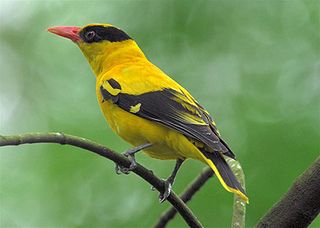
The Old World orioles (Oriolidae) are an Old World family of passerine birds.
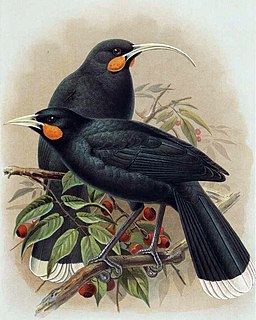
Callaeidae is a family of passerine birds endemic to New Zealand. It contains three genera, with five species in the family. One species, the huia, became extinct early in the 20th century, while the South Island kokako is critically endangered and may be extinct.

The huia is an extinct species of New Zealand wattlebird, endemic to the North Island of New Zealand. The last confirmed sighting of a huia was in 1907, although there were credible sightings into the 1960s.

The bushwren, bush wren, or mātuhituhi in Māori, was a very small and almost flightless bird that was endemic to New Zealand. It had three subspecies on each of the major islands of New Zealand, the North Island, South Island, and Stewart Island and nearby smaller islands. The species disappeared gradually after the introduction of invasive mammalian predators, last being seen on the North Island in 1955 and the South Island in 1968. Attempts were made to save the remaining population on small islands off Stewart Island, but they ultimately failed with the death of the last remaining known birds in 1972.

The South Island takahē, also known as the notornis, is a flightless swamphen indigenous to New Zealand, and the largest living member of the rail family. It was hunted extensively by Māori, but was not named and described by Europeans until 1847, and then only from fossil bones. In 1850 a living bird was captured, and three more collected in the 19th century. After another bird was captured in 1898, and no more were to be found, the species was presumed extinct. Fifty years later, however, after a carefully planned search, takahē were dramatically rediscovered in 1948 by Geoffrey Orbell in an isolated valley in the South Island's Murchison Mountains. The species is now managed by the New Zealand Department of Conservation, whose Takahē Recovery Programme maintains populations on several offshore islands as well as Takahē Valley. It has now been reintroduced to a second mainland site in Kahurangi National Park. Although takahē are still a threatened species, their NZTCS status was downgraded in 2016 from Nationally Critical to Nationally Vulnerable. The population is 418 and is growing by 10 percent per year.
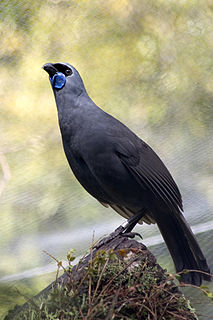
Kōkako (Callaeas) are two species of endangered forest birds which are endemic to New Zealand, the North Island kōkako and the presumably extinct South Island kōkako. They are both slate-grey with wattles and have black masks. They belong to a genus containing five known species of New Zealand wattlebird, the other three being two species of tieke (saddleback) and the extinct huia. Previously widespread, kōkako populations throughout New Zealand have been decimated by the predations of mammalian invasive species such as possums, stoats, cats and rats, and their range has contracted significantly. In the past this bird was called the New Zealand crow; however, it is not a crow at all, but it looks like one from a distance.

Lyall's wren or the Stephens Island wren is a small, extinct, flightless passerine belonging to the family Acanthisittidae, the New Zealand wrens. It was once found throughout New Zealand, but when it came to the attention of scientists in 1894, its last refuge was Stephens Island in Cook Strait. Often claimed to be a species driven extinct by a single creature, the wren in fact fell victim to the island's numerous feral cats. The wren was described almost simultaneously by both Walter Rothschild and Walter Buller. It became extinct shortly after.

The laughing owl, also known as whēkau or the white-faced owl, was an endemic owl of New Zealand. Plentiful when European settlers arrived in New Zealand, its scientific description was published in 1845, but it was largely or completely extinct by 1914. The species was traditionally considered to belong to the monotypic genus SceloglauxKaup, 1848, although recent genetic studies indicate that it belongs with the boobook owls in the genus Ninox.

The stitchbird or hihi is a honeyeater-like bird endemic to the North Island and adjacent offshore islands of New Zealand. Its evolutionary relationships have long puzzled ornithologists, but it is now classed as the only member of its own family, the Notiomystidae. It became rare, being extirpated everywhere except Little Barrier Island, but has been reintroduced to two other island sanctuaries and four locations on the North Island mainland.
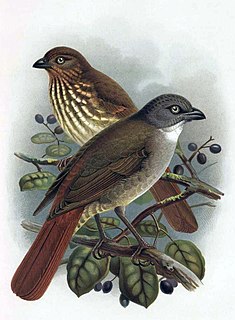
The piopios or turnagras are an extinct genus of passerine birds in the family Oriolidae, that were endemic to New Zealand. Sometimes described as New Zealand thrushes, the piopios had only a coincidental, passing resemblance to the thrush family.

The South Island piopio also known as the New Zealand thrush, was a passerine bird of the family Oriolidae.

The saddlebacks are two species of New Zealand bird of the family Callaeidae. Both are glossy black with a chestnut saddle. Its taxonomic family is also known as that of the "wattlebirds" and includes the two subspecies of the kōkako as well as the extinct huia. All members of the family Callaeidae have coloured fleshy appendages on either side of the beak, known as wattles; Saddlebacks' wattles are a vivid red.
The Mauke starling or mysterious starling was a species of starling found on the island of Mauke, Cook Islands. It is now extinct. The binomen is the result of Buller's misreading of the name inornata on the specimen label. As he seems to have genuinely believed this spelling to be correct, the binomial, although it has no meaning, is valid.
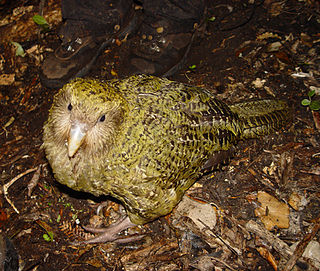
The birds of New Zealand evolved into an avifauna that included many endemic species found in no other country. As an island archipelago, New Zealand accumulated bird diversity, and when Captain James Cook arrived in the 1770s he noted that the bird song was deafening.
Rallicola extinctus is an extinct species of phtilopterid louse. This parasite was only known to live on the now extinct huia and is thought to have become extinct with its host. It was initially placed in its own separate genus, Huiacola, which means "huia inhabitant". It was endemic to New Zealand's North Island.
Hodgens' waterhen is an extinct rail species from New Zealand. Its name commemorates the Hodgen brothers who were owners of the Pyramid Valley swamp where the holotype was discovered. It reached a weight of 280 g and its wings were so reduced that it was unable to fly. It occupied a wide range of habitats, including open forest and grassland along riverbanks.
The New Zealand musk duck, also known as de Lautour's duck, is an extinct stiff-tailed duck native to New Zealand. It is only known from subfossil bones. Its closest relative was the living Australian musk duck Biziura lobata, with which it has sometimes been combined.

The South Island kōkako is a possibly extinct forest bird endemic to the South Island of New Zealand. Unlike its close relative, the North Island kōkako, it has largely orange wattles, with only a small patch of blue at the base, and was also known as the orange-wattled crow. The last accepted sighting in 2007 was the first considered genuine since 1967, although there have been several other unauthenticated reports.















